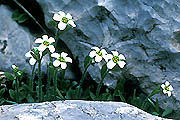 |
|
|
|
|
|
|
The outstanding diversity of abiotic life conditions allows colonization by numerous differentially adapted plant species leading thereby to the great richness of vascular plant species in mountainous regions. The world map depicted here shows
|
|
|
This world map shows hot spots of vascular plant diversity in mountainous regions. Use your mouse to reveal the names of the mountainous regions. |
| This map is based on the map of "Global Biodiversity: Species Numbers of Vascular Plants" (Barthlott et al. 1997) and the study on "Centres of Plant Diversity" (Davis et al. 1994). Basic world map adapted from Schweizer Weltatlas (1994), © EDK, reproduction kindly allowed. |
 1 1
 2 2
 3 3
 4 4
 5 5
 6 6
 7 7 |
|
| 1. | Saxifraga oppositifolia on humid soil in a snow patch (2400 m) |
| 2. | Saxifraga aizoides on humid soil between calcareous boulders (2500 m) |
| 3. | Saxifraga aphylla on a calcareous rock terrace (2900 m) |
| 4. | Saxifraga bryoides on stabilised, siliceous scree (2100 m) |
| 5. | Saxifraga biflora subsp. macropetala on a calcareous slate rock (2750 m) |
| 6. | Saxifraga muscoides on stony soil rich in calcium (2500 m) |
| 7. | Saxifraga androsacea in a stony snow patch on limestone (2200 m) |
29 August 2011 |
||
| |
||